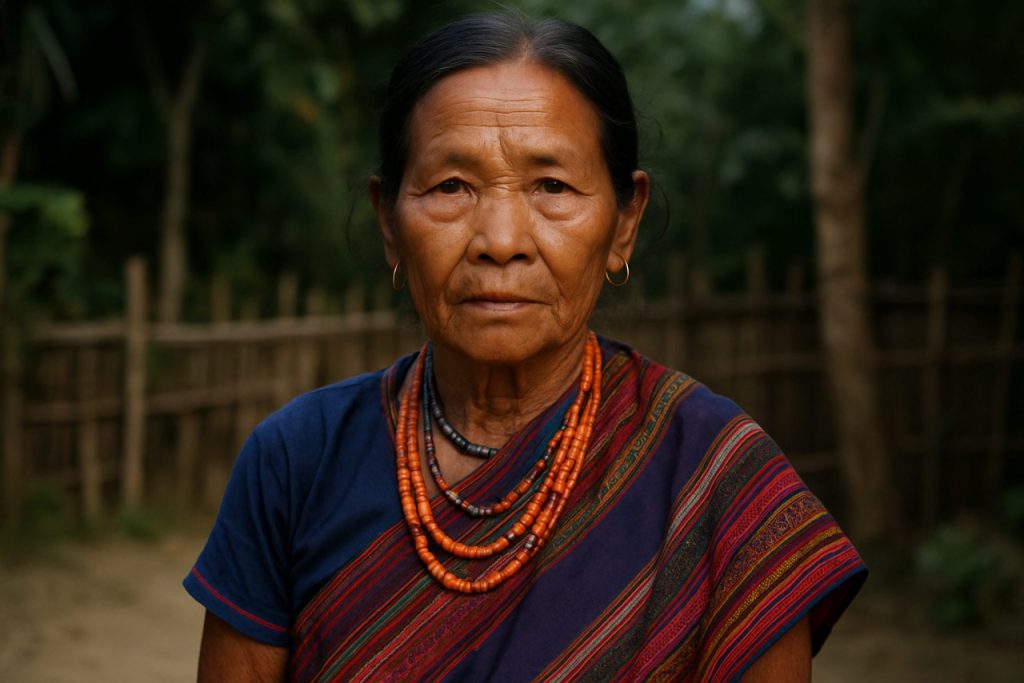
Inside the World of the Khyang: Exploring the Rich Heritage, Challenges, and Future of Bangladesh’s Enigmatic Ethnic Group. Discover Their Traditions, Resilience, and Evolving Identity. (2025)
- Introduction: Who Are the Khyang?
- Historical Origins and Migration Patterns
- Language, Oral Traditions, and Storytelling
- Social Structure and Community Life
- Traditional Beliefs, Rituals, and Festivals
- Art, Craftsmanship, and Material Culture
- Contemporary Challenges: Land, Rights, and Representation
- Education, Technology Adoption, and Youth Perspectives
- Public Interest and Cultural Preservation: Trends and Forecasts
- Future Outlook: Sustainability, Growth, and Global Awareness
- Sources & References
Introduction: Who Are the Khyang?
The Khyang are one of the indigenous ethnic groups residing primarily in the Chittagong Hill Tracts (CHT) of southeastern Bangladesh. With a population estimated to be in the low thousands, the Khyang are among the smaller ethnic minorities in the region. Their presence is concentrated mainly in the Bandarban and Rangamati districts, where they live in compact villages often situated on hill slopes. The Khyang are recognized as a distinct indigenous community by the Government of Bangladesh, which acknowledges the unique cultural, linguistic, and social characteristics that set them apart from the majority Bengali population and other indigenous groups in the CHT.
The Khyang trace their origins to the broader Tibeto-Burman ethnolinguistic family, sharing historical and cultural affinities with neighboring groups such as the Marma, Mro, and Chakma. Their language, also called Khyang, belongs to the Sino-Tibetan language family, though it is considered endangered due to the small number of speakers and the increasing influence of dominant regional languages. Traditionally, the Khyang have maintained a subsistence lifestyle based on shifting cultivation (jhum), hunting, and gathering, with social structures organized around clan-based leadership and customary laws.
Religiously, the Khyang community practices a blend of Theravada Buddhism and indigenous animist beliefs. Buddhist rituals and festivals play a central role in their communal life, often centered around village monasteries that serve as both religious and social institutions. The Khyang are also known for their rich oral traditions, including folk tales, songs, and rituals that are passed down through generations, preserving their collective memory and identity.
Despite their longstanding presence in the Chittagong Hill Tracts, the Khyang, like other indigenous peoples in Bangladesh, have faced challenges related to land rights, cultural preservation, and access to education and healthcare. National and international organizations, including the United Nations, have recognized the importance of protecting the rights and heritage of indigenous groups such as the Khyang. The Government of Bangladesh, through its Ministry of Chittagong Hill Tracts Affairs, is tasked with addressing the unique needs of these communities and promoting their socio-economic development.
Understanding the Khyang is essential for appreciating the rich tapestry of ethnic diversity in Bangladesh and for ensuring that the voices and traditions of smaller indigenous groups are respected and preserved in the face of modernization and demographic change.
Historical Origins and Migration Patterns
The Khyang ethnic group, one of the smaller indigenous communities of Bangladesh, primarily resides in the Chittagong Hill Tracts (CHT), a region known for its rich tapestry of ethnic diversity. The historical origins of the Khyang are closely intertwined with the broader migration patterns of Tibeto-Burman-speaking peoples in Southeast Asia. Linguistic and anthropological evidence suggests that the Khyang are part of the larger Chin-Kuki-Mizo ethnolinguistic family, which traces its roots to the highlands of present-day Myanmar and adjacent areas. Over centuries, waves of migration—driven by factors such as inter-tribal conflict, search for arable land, and shifting political boundaries—brought the Khyang and related groups into the hilly terrains of southeastern Bangladesh.
Oral traditions among the Khyang recount ancestral migrations from the Arakan (now Rakhine) region of Myanmar. These narratives are supported by linguistic affinities between the Khyang language and other Chin languages spoken in Myanmar, indicating a shared heritage. The migration is believed to have occurred in several phases, with the earliest groups arriving in the CHT possibly as early as the 17th or 18th century. The Khyang settled in remote, forested areas, maintaining a distinct identity through their language, customs, and social organization.
The Chittagong Hill Tracts, comprising the districts of Bandarban, Rangamati, and Khagrachari, have historically served as a refuge for various indigenous groups, including the Khyang. The region’s rugged terrain and relative isolation allowed these communities to preserve their traditional ways of life, even as the surrounding plains underwent significant demographic and political changes. The Khyang, like other indigenous peoples of the CHT, practiced shifting cultivation (jhum) and maintained clan-based social structures.
Colonial and post-colonial administrative changes, particularly during British rule and after the partition of India, further influenced the settlement patterns of the Khyang. The demarcation of borders and the creation of new administrative units sometimes led to the displacement or consolidation of Khyang villages. Despite these challenges, the Khyang have retained a strong sense of communal identity, rooted in their historical experiences of migration and adaptation to the unique environment of the Chittagong Hill Tracts.
Today, the Khyang remain a recognized indigenous group within Bangladesh, with their historical origins and migration patterns forming a crucial part of the broader narrative of the region’s ethnolinguistic diversity. Their continued presence in the CHT underscores the enduring legacy of historical migrations in shaping the cultural landscape of Bangladesh. For more information on indigenous peoples in Bangladesh, including the Khyang, see United Nations and International Work Group for Indigenous Affairs.
Language, Oral Traditions, and Storytelling
The Khyang ethnic group, residing primarily in the Chittagong Hill Tracts of southeastern Bangladesh, possesses a rich linguistic and oral heritage that is integral to their cultural identity. The Khyang language, classified within the Sino-Tibetan language family, is distinct yet shares affinities with other regional languages spoken by neighboring indigenous communities. Despite its uniqueness, the Khyang language is considered endangered, with a declining number of fluent speakers, particularly among the younger generation. This trend is influenced by the increasing dominance of Bengali, the national language, in education and public life, which has led to a gradual language shift within Khyang communities.
Oral traditions play a central role in the preservation and transmission of Khyang cultural knowledge. Storytelling, folk songs, and oral histories are vital mediums through which the Khyang pass down their collective memory, values, and social norms. Elders and community leaders are often the custodians of these oral traditions, recounting tales of ancestral origins, migration, and the moral lessons embedded in mythological narratives. These stories not only entertain but also serve as educational tools, reinforcing communal bonds and guiding younger generations in understanding their heritage.
Khyang storytelling is typically performed during communal gatherings, festivals, and important life events. The oral narratives often incorporate elements of nature, spirituality, and the historical experiences of the Khyang people, reflecting their close relationship with the environment and their resilience in the face of external pressures. Folk songs, known for their melodic simplicity and evocative lyrics, are another important aspect of Khyang oral culture. These songs are performed during rituals, agricultural cycles, and social celebrations, providing a sense of continuity and belonging.
Efforts to document and revitalize the Khyang language and oral traditions are ongoing, with support from local organizations and cultural preservation initiatives. These efforts aim to create written records of oral literature, develop educational materials in the Khyang language, and encourage intergenerational transmission of traditional knowledge. Such initiatives are crucial for safeguarding the intangible cultural heritage of the Khyang, as recognized by international frameworks like the UNESCO Convention for the Safeguarding of the Intangible Cultural Heritage. The preservation of Khyang language and oral traditions not only enriches Bangladesh’s cultural diversity but also upholds the rights of indigenous peoples to maintain and develop their own cultural expressions.
Social Structure and Community Life
The Khyang ethnic group, one of the smaller indigenous communities in Bangladesh, primarily resides in the Chittagong Hill Tracts (CHT), particularly in the Bandarban and Rangamati districts. Their social structure is traditionally organized around clan-based systems, with each clan (locally called “khyang”) tracing descent from a common ancestor. The Khyang community is led by a hereditary chief known as the “Karbari” or “Headman,” who plays a central role in conflict resolution, land allocation, and the preservation of customary laws. The Karbari is supported by a council of elders, whose authority is respected in both social and religious matters.
Khyang society is largely egalitarian, with communal decision-making processes and a strong emphasis on collective welfare. Extended families often live in close proximity, forming compact villages on hill slopes. Houses are typically built on stilts using bamboo and wood, reflecting adaptation to the hilly terrain and monsoon climate. Social cohesion is reinforced through communal labor, especially during agricultural activities such as jhum (shifting cultivation), which remains the primary livelihood for most Khyang families.
Community life is marked by a rich tradition of oral storytelling, music, and dance, which serve both as entertainment and as means of transmitting cultural values and historical narratives. Festivals and rituals, often linked to the agricultural calendar, are important occasions for social gathering and the reaffirmation of group identity. The Khyang practice a blend of animism and Buddhism, with religious leaders (Buddhist monks or local shamans) guiding spiritual life and officiating at ceremonies such as weddings, funerals, and harvest festivals.
Education and healthcare access remain limited in many Khyang villages, though efforts by the Government of Bangladesh and organizations such as the UNICEF and the International Labour Organization have sought to improve basic services and promote indigenous rights. Despite these initiatives, the Khyang continue to face challenges related to land rights, cultural preservation, and integration with mainstream society. Community-based organizations, often supported by national and international NGOs, play a growing role in advocating for the Khyang’s social and economic development.
Overall, the Khyang’s social structure and community life reflect a resilient adaptation to their environment and a strong commitment to cultural continuity, even as they navigate the pressures of modernization and external influences in contemporary Bangladesh.
Traditional Beliefs, Rituals, and Festivals
The Khyang ethnic group, one of the smaller indigenous communities in the Chittagong Hill Tracts of Bangladesh, maintains a rich tapestry of traditional beliefs, rituals, and festivals that are integral to their cultural identity. Their spiritual worldview is deeply rooted in animism, with a strong reverence for nature and ancestral spirits. The Khyang believe that various natural elements—such as rivers, forests, and mountains—are inhabited by spirits (known locally as “nats”), which must be respected and appeased to ensure communal well-being and harmony.
Central to Khyang religious practice is the veneration of ancestors and the performance of rituals to honor both benevolent and malevolent spirits. Ritual specialists, often referred to as shamans or spiritual leaders, play a pivotal role in mediating between the human and spirit worlds. These specialists conduct ceremonies to ward off misfortune, cure illnesses, and bless important life events such as births, marriages, and harvests. Offerings of rice, fruits, and domesticated animals are common during these rituals, symbolizing gratitude and seeking protection from supernatural forces.
Festivals among the Khyang are closely tied to the agricultural calendar and cycles of nature. The most significant festival is the “Biju” or “Bizu,” celebrated in the spring to mark the traditional New Year and the beginning of the sowing season. During Biju, Khyang families clean their homes, prepare special foods, and participate in communal feasts and dances. Ritual bathing in rivers is a key feature, believed to purify individuals and bring good fortune for the coming year. The festival also serves as a time for reconciliation, social bonding, and the renewal of communal ties.
Other important observances include harvest festivals and ceremonies dedicated to specific spirits or deities associated with particular localities or clans. These events often involve music, dance, and the recitation of oral histories, reinforcing the transmission of cultural knowledge across generations. Despite the influence of Buddhism and Christianity in the region, many Khyang continue to uphold their indigenous practices, blending them with newer religious elements in a process of syncretism.
The preservation of Khyang traditional beliefs and festivals is supported by local community organizations and advocacy groups working to protect indigenous rights and cultural heritage in Bangladesh. These efforts are recognized by national and international bodies, including the UNESCO, which highlights the importance of safeguarding intangible cultural heritage for minority communities worldwide.
Art, Craftsmanship, and Material Culture
The Khyang ethnic group, residing primarily in the Chittagong Hill Tracts of southeastern Bangladesh, possesses a rich tradition of art, craftsmanship, and material culture that reflects their unique identity and adaptation to their environment. Their artistic expressions are deeply intertwined with daily life, spiritual beliefs, and communal values, manifesting in textiles, basketry, woodwork, and ritual objects.
Textile production is a cornerstone of Khyang material culture. Khyang women are skilled weavers, utilizing backstrap looms to create traditional garments such as the thami (women’s wrap) and angi (blouse). These textiles are often adorned with geometric patterns and vibrant colors, each motif carrying symbolic meaning related to nature, fertility, and social status. The weaving process is not only a practical activity but also a means of transmitting cultural knowledge across generations.
Basketry is another prominent craft among the Khyang. Using locally sourced bamboo and cane, artisans produce a variety of utilitarian items, including baskets for carrying crops, storage containers, and fish traps. The intricate weaving techniques and designs demonstrate both functional ingenuity and aesthetic sensibility. These items are essential for daily subsistence activities and are often exchanged within the community, reinforcing social bonds.
Woodworking is also significant in Khyang culture. Skilled craftsmen carve household implements, agricultural tools, and ritual objects from locally available timber. Notably, the Khyang construct traditional houses on stilts, using wood and bamboo, with architectural features adapted to the hilly terrain and monsoon climate. The design and ornamentation of these structures reflect both environmental adaptation and cultural values, such as communal living and respect for ancestral traditions.
Ritual and ceremonial objects occupy a special place in Khyang material culture. Items such as wooden effigies, ceremonial drums, and masks are used in religious festivals and rites of passage. These artifacts are imbued with spiritual significance, serving as mediators between the human and spirit worlds. The creation and use of such objects are guided by traditional knowledge and are often restricted to specific members of the community, such as elders or ritual specialists.
The preservation and transmission of Khyang art and craftsmanship face challenges due to modernization, economic pressures, and limited access to resources. However, efforts by local organizations and cultural advocates aim to document and revitalize these traditions, recognizing their importance for cultural identity and sustainable development. The UNESCO and the Government of the People's Republic of Bangladesh have acknowledged the significance of indigenous crafts in the broader context of Bangladesh’s cultural heritage.
Contemporary Challenges: Land, Rights, and Representation
The Khyang ethnic group, one of the smaller indigenous communities in the Chittagong Hill Tracts (CHT) of Bangladesh, faces a range of contemporary challenges related to land rights, legal recognition, and political representation. These issues are deeply rooted in historical marginalization and have been exacerbated by ongoing socio-political dynamics in the region.
Land rights remain a central concern for the Khyang. Traditionally, the Khyang have practiced shifting cultivation (jhum) and maintained communal land ownership systems. However, the expansion of state-controlled forest reserves, settlement of non-indigenous populations, and development projects have led to significant encroachment on their ancestral lands. The implementation of the 1900 Chittagong Hill Tracts Regulation, which once provided some protection for indigenous land tenure, has been inconsistently enforced, resulting in frequent land disputes and dispossession. The United Nations has repeatedly highlighted the vulnerability of indigenous peoples in Bangladesh to land alienation and called for stronger legal safeguards.
Legal recognition and the protection of indigenous rights are further complicated by the lack of specific constitutional acknowledgment of the Khyang and other indigenous groups. While the 1997 Chittagong Hill Tracts Peace Accord was a landmark agreement intended to address the rights and autonomy of indigenous peoples in the region, its implementation has been partial and slow. Key provisions, such as the resolution of land disputes through the CHT Land Dispute Resolution Commission and the devolution of administrative powers to local councils, remain incomplete. This has left the Khyang with limited recourse to justice and little influence over decisions affecting their territories.
Political representation is another significant challenge. The Khyang, being a numerically small group, are often underrepresented in local and regional governance structures. The CHT Regional Council and Hill District Councils, established to ensure indigenous participation, are dominated by larger ethnic groups, making it difficult for the Khyang to advocate effectively for their interests. This underrepresentation extends to national policymaking, where indigenous voices are rarely included in legislative processes.
In addition to these structural issues, the Khyang face social and economic marginalization, limited access to education and healthcare, and threats to their cultural heritage. National and international organizations, including the International Labour Organization, have called for the full implementation of the Peace Accord, legal reforms to recognize indigenous rights, and targeted measures to ensure the inclusion and protection of smaller groups like the Khyang. Addressing these challenges is essential for safeguarding the rights, dignity, and future of the Khyang people in Bangladesh.
Education, Technology Adoption, and Youth Perspectives
The Khyang ethnic group, one of the smaller indigenous communities in the Chittagong Hill Tracts (CHT) of Bangladesh, faces unique challenges and opportunities in the realms of education, technology adoption, and youth development. Traditionally, the Khyang have maintained a subsistence lifestyle, with education historically limited by geographic isolation, language barriers, and limited infrastructure. However, recent years have seen gradual improvements, driven by both governmental and non-governmental initiatives aimed at increasing educational access and quality for indigenous peoples.
The Government of Bangladesh, through the Ministry of Chittagong Hill Tracts Affairs, has implemented targeted programs to enhance educational opportunities for indigenous groups, including the Khyang. These efforts include the establishment of primary schools in remote areas, provision of stipends, and the development of mother-tongue-based multilingual education. Despite these initiatives, Khyang children often face higher dropout rates and lower literacy levels compared to national averages, due in part to economic hardship, language differences, and limited secondary school access.
Technology adoption among the Khyang remains in its nascent stages. Mobile phone penetration has increased in the CHT, providing new avenues for communication and access to information. However, internet connectivity is still limited in many Khyang villages, restricting the community’s ability to benefit fully from digital resources. The Bangladesh Telecommunication Regulatory Commission has outlined plans to expand rural connectivity, which could facilitate greater access to online educational materials and government services in the coming years.
Khyang youth are increasingly aware of the transformative potential of education and technology. Many express aspirations for higher education and skilled employment, both within and outside their traditional communities. Youth organizations and local NGOs play a vital role in fostering leadership, digital literacy, and cultural preservation among Khyang adolescents. These groups often collaborate with national bodies such as the Ministry of Education to advocate for culturally sensitive curricula and to bridge the digital divide.
Looking ahead to 2025, the perspectives of Khyang youth are shaped by a desire to balance cultural identity with participation in the broader socio-economic landscape of Bangladesh. Continued investment in education infrastructure, teacher training, and digital inclusion will be critical to empowering the next generation of Khyang leaders and ensuring their meaningful participation in national development.
Public Interest and Cultural Preservation: Trends and Forecasts
The Khyang ethnic group, one of the smaller indigenous communities in Bangladesh, primarily resides in the Chittagong Hill Tracts (CHT). In recent years, public interest in the cultural heritage and preservation of the Khyang has grown, driven by both national and international recognition of indigenous rights and cultural diversity. This trend is expected to continue into 2025, influenced by several key factors.
Governmental and non-governmental organizations have increasingly prioritized the documentation and safeguarding of minority cultures. The UNESCO, for example, has highlighted the importance of intangible cultural heritage, which includes the languages, rituals, and traditional knowledge of groups like the Khyang. In Bangladesh, the Ministry of Chittagong Hill Tracts Affairs, established to address the unique needs of the region’s indigenous peoples, has initiated programs aimed at promoting cultural preservation and social inclusion.
Public interest is also reflected in academic and civil society initiatives. Universities and research institutions in Bangladesh have expanded ethnographic studies and language documentation projects focused on the Khyang and other indigenous groups. These efforts are often supported by international partners and are expected to yield more comprehensive cultural records by 2025. Additionally, local NGOs are working to revitalize traditional crafts, music, and festivals, which serve both as cultural preservation and as a means of economic empowerment for Khyang communities.
Forecasts for 2025 suggest that digital technology will play a significant role in cultural preservation. The increasing availability of mobile devices and internet access in the CHT region enables the recording and sharing of oral histories, folklore, and traditional practices. This digital shift is anticipated to foster greater intergenerational transmission of Khyang culture and to connect the community with broader audiences, both nationally and globally.
However, challenges remain. The Khyang face ongoing pressures from land encroachment, migration, and socio-economic marginalization, which threaten their cultural continuity. National policy frameworks, such as the implementation of the Chittagong Hill Tracts Peace Accord, are critical to ensuring the rights and cultural autonomy of indigenous groups. Organizations like the International Labour Organization have emphasized the need for inclusive development policies that respect indigenous identities.
In summary, the outlook for public interest and cultural preservation of the Khyang ethnic group in 2025 is cautiously optimistic. Continued collaboration between government bodies, international organizations, and local communities will be essential to safeguarding the unique heritage of the Khyang for future generations.
Future Outlook: Sustainability, Growth, and Global Awareness
The future outlook for the Khyang ethnic group of Bangladesh is shaped by a complex interplay of sustainability challenges, prospects for socio-economic growth, and increasing global awareness of indigenous rights. As a small indigenous community primarily residing in the Chittagong Hill Tracts, the Khyang face unique opportunities and threats in the coming years.
Sustainability remains a central concern for the Khyang, whose traditional livelihoods are closely tied to the natural environment. Shifting cultivation, forest resource use, and small-scale agriculture are integral to their way of life. However, environmental pressures such as deforestation, land degradation, and climate change threaten these practices. National and international organizations, including the United Nations, have highlighted the importance of supporting indigenous peoples in adapting to environmental changes while preserving their cultural heritage. Sustainable development initiatives that respect traditional knowledge and promote community-led resource management are increasingly recognized as essential for the Khyang’s resilience.
Socio-economic growth for the Khyang hinges on improved access to education, healthcare, and economic opportunities. Governmental bodies like the Government of the People's Republic of Bangladesh have implemented policies aimed at uplifting indigenous communities, though challenges remain in ensuring equitable distribution of resources and representation. Empowerment through education and skills training is expected to play a pivotal role in enabling the Khyang to participate more fully in the national economy while maintaining their cultural identity.
Global awareness of indigenous issues is on the rise, driven by advocacy from organizations such as the UNESCO and the Office of the United Nations High Commissioner for Human Rights. These bodies emphasize the protection of linguistic and cultural diversity, as well as the rights of indigenous peoples to land and self-determination. The Khyang, like other indigenous groups, stand to benefit from international frameworks such as the United Nations Declaration on the Rights of Indigenous Peoples, which calls for the protection and promotion of their rights on a global stage.
Looking ahead to 2025 and beyond, the sustainability and growth of the Khyang ethnic group will depend on collaborative efforts between the community, government, and international partners. By fostering inclusive development, respecting traditional knowledge, and amplifying indigenous voices in policy-making, there is potential for the Khyang to achieve greater socio-economic security and cultural vitality, while contributing to the broader goals of diversity and sustainability in Bangladesh.



